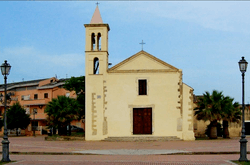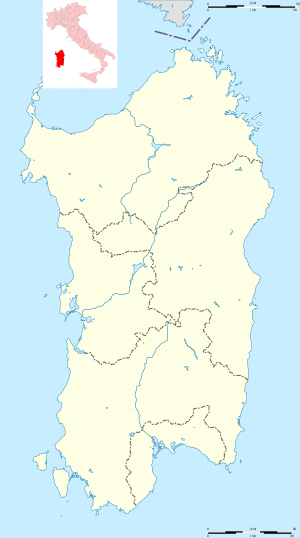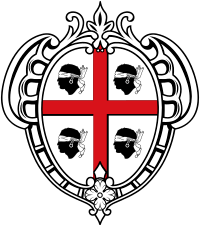Decimomannu
| Decimomannu Deximumannu | ||
|---|---|---|
| Comune | ||
| Comune di Decimomannu | ||
 Church of Santa Greca | ||
| ||
 Decimomannu Location of Decimomannu in Sardinia | ||
| Coordinates: 39°19′N 8°58′E / 39.317°N 8.967°E | ||
| Country | Italy | |
| Region | Sardinia | |
| Metropolitan city | Cagliari (CA) | |
| Government | ||
| • Mayor | Anna Paola Marongiu | |
| Area | ||
| • Total | 28.1 km2 (10.8 sq mi) | |
| Elevation | 12 m (39 ft) | |
| Population (30 September 2014)[1] | ||
| • Total | 8,115 | |
| • Density | 290/km2 (750/sq mi) | |
| Demonym(s) | Decimesi | |
| Time zone | UTC+1 (CET) | |
| • Summer (DST) | UTC+2 (CEST) | |
| Postal code | 09033 | |
| Dialing code | 070 | |
Decimomannu (Deximumannu or Deximu Mannu in Sardinian language) is a comune (municipality) in the Metropolitan City of Cagliari in the Italian autonomous region of Sardinia.
Decimomannu is located about 17 kilometres (11 mi) northwest of Cagliari, and, As of 2014, it has a population of about 8,115.[1]
Decimomannu borders the municipalities of Assemini, Decimoputzu, San Sperate, Siliqua, Uta, Villasor, and Villaspeciosa. It is served by a railway station connecting it to Iglesias, Golfo Aranci and Cagliari.
History
Decimomannu's origins date back at least to Roman times, as attested by its Latin name, meaning "the biggest town located ten miles from Cagliari". Its earlier history was revealed when a necropolis from Phoenician-Punic times was found in 1879–80. It was the location of the battle of Decimomannu during the revolt of Hampsicora.
After belonging to the Byzantine Empire, in the Middle Ages it became part of the Giudicato of Cagliari. Several giudici (from Latin iudice, literally "judge") established their residences in Decimomannu. After the fall of the Giudicato of Cagliari, Decimomannu belonged to the Della Gherardesca family from Pisa. The Battle of Lucocisterna, fought between the Pisane and the Aragonese, took place here in 1324, and after it the town belonged to the latter (with the exception of a short period under the Giudicato of Arborea in 1353-1355). Decimomannu was part of the Kingdom of Sardinia in the Spanish Empire until 1708, when, together with the whole Sardinia, came under Piedmontese rule in 1720.
Main sights
- Church of Sant'Antonio Abate (16th century), in Gothic-Catalan style
- Church of Santa Greca, built in 1777 above a pre-existing one dating perhaps from around 1500.
- Roman Bridge, crossing the Rio Mannu river
References
| Wikimedia Commons has media related to Decimomannu. |

